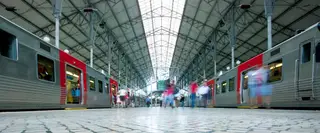Currently, with the instruments we have available, going from one point to another, moving, is incrementally easier, whether in the city or outside of it. There are more paths and choices in terms of transportation. In practical terms, our mobility is better. But going from one point to the other according to our needs is a different story. We are much more limited, which impacts our daily life and quality of living. So, more than improving mobility, the real challenge of the future relies in finding innovative solutions to increase accessibility.

Rosário Macário, Transport researcher and teacher at the Department of Civil Engineering, Architecture and Georresources of Instituto Superior Técnico, believes that access equals quality of life, and sustainability and competitiveness in cities
Rosário Macário, Transport researcher and teacher at the Department of Civil Engineering, Architecture and Georresources of Instituto Superior Técnico, has no doubts that “quality of live is the access not the mobility and the paradigm shift, from mobility to accessibility, is, indeed, a paramount challenge”, she adds. An idea that, also, reinforces the need to fight the desertification phenomenon of city centres, a measure that would benefit both people and the environment: “If we want to have a good quality of life today we need to live in proximity, that is, being able to get to the end of a working day and have a social and family period, one that is usually spent ‘in traffic’”. The tendency, for economic reasons, is to live further away from big urban city centres. But the truth is “living in proximity and having a mobility system well organized and spread, makes people soon realise the advantages of not using their cars”.
FROM TECHNOLOGY TO TERRITORIAL PLANNING AND TO SOCIAL DEVELOPMENT
One of the solutions to ensure better accessibility may rely in the adoption of mobility systems that offer integration and sharing, real time customisation of information and articulation of fares. Technology and digitalization are an opportunity for these systems to come true, but they are only a component of the process. According to Rui Camolino, president of ITS-Portugal - Association for the Development of Mobility and Sustainable Transportation, “technical aspects are relevant but frequently we must also intervene in the territorial planning aspects, in order to assess the best form of standardising certain components that ought to be available to citizens, within the territory, so to facilitate their access”. In his opinion, good accessibility not only promotes economic development but also allows people to have better connections between them: “There is a homogenization of society, higher equity”.

Rui Camolino and José Tomás Baganha, of ITS-Portugal — Association for the Development of Mobility and Sustainable Transportation, consider that intelligent transportation systems are a key factor to mobility/ accessibility in the future. Covering this topic, the Association is organizing an European congress which will take place on May 2020
This idea is supported by José Tomas Baganha, secretary-general of this association, who gives the example of two social groups for whom good accessibility works as an inclusion factor: older people, a main part of Western societies, and people with reduced mobility. “Accessibility is key to integrate these groups of people and improve their relationships with society at large, thus promoting social development”, he stresses.
In short, the topic of urban accessibility is on the agenda not only from the perspective of the individual citizen who needs transportation, but also in the perspective of territorial organization and city planning. When this is high it comprises a factor of social, economic and cultural development, which contributes to general well-being and quality of life.
To reach this level, both ITS experts support the need to invest in the urban planning of cities, where there is plenty to be done, in training, in providing information to citizens, in intelligent sustainable and integrated transportation and in the awareness for the delineation of long-term policies.
Planning, decarbonisation, digitalize and innovate are, therefore, some of the main challenges for the upcoming decade.
